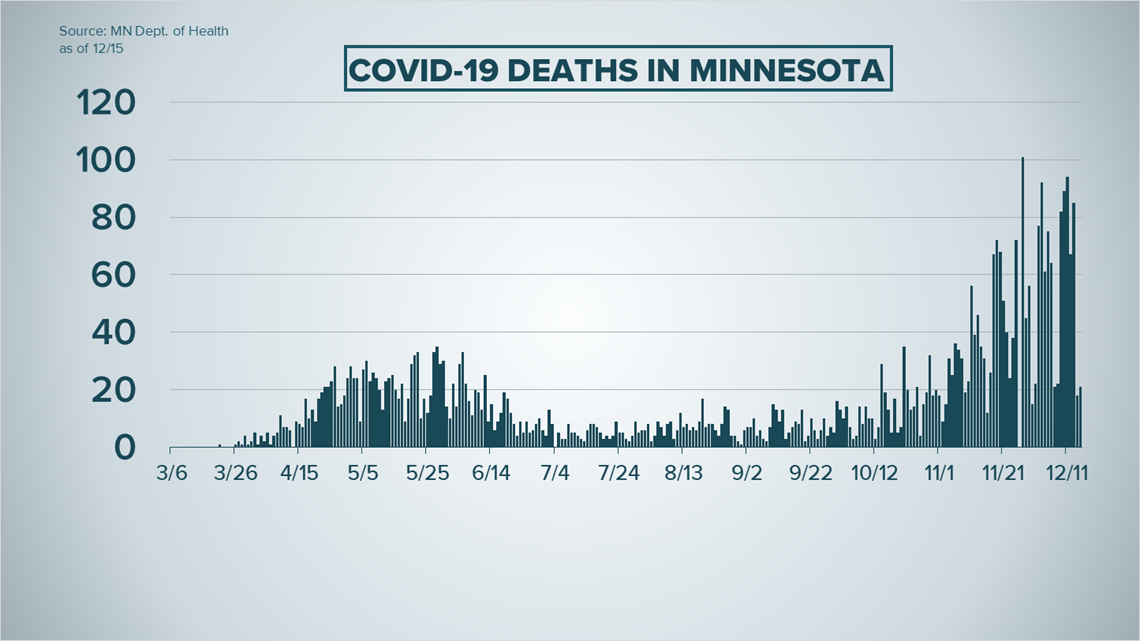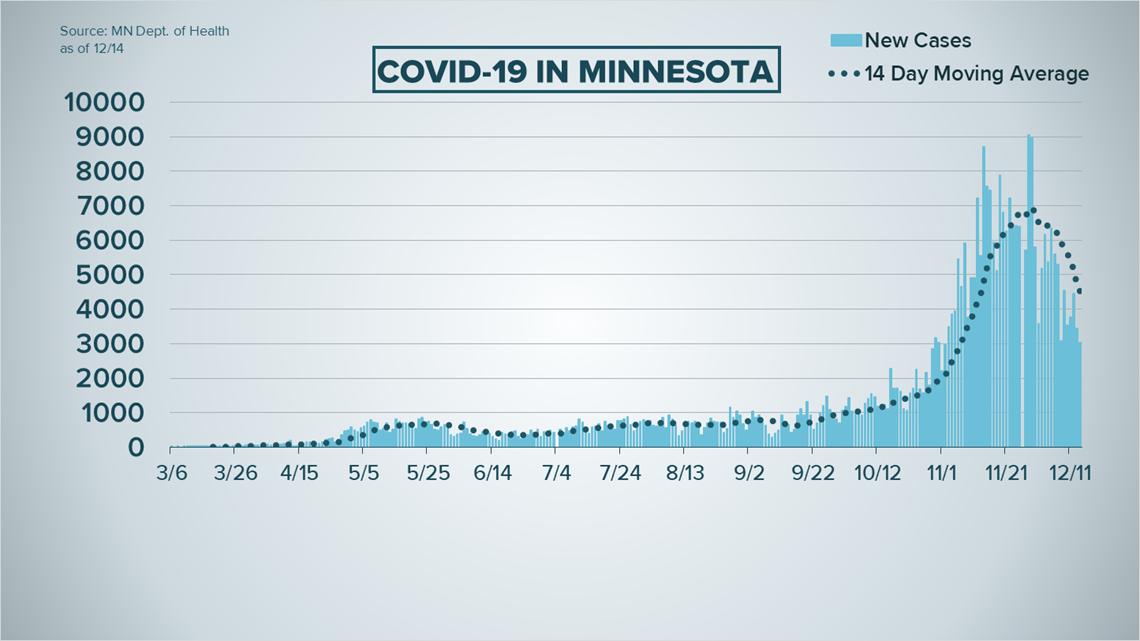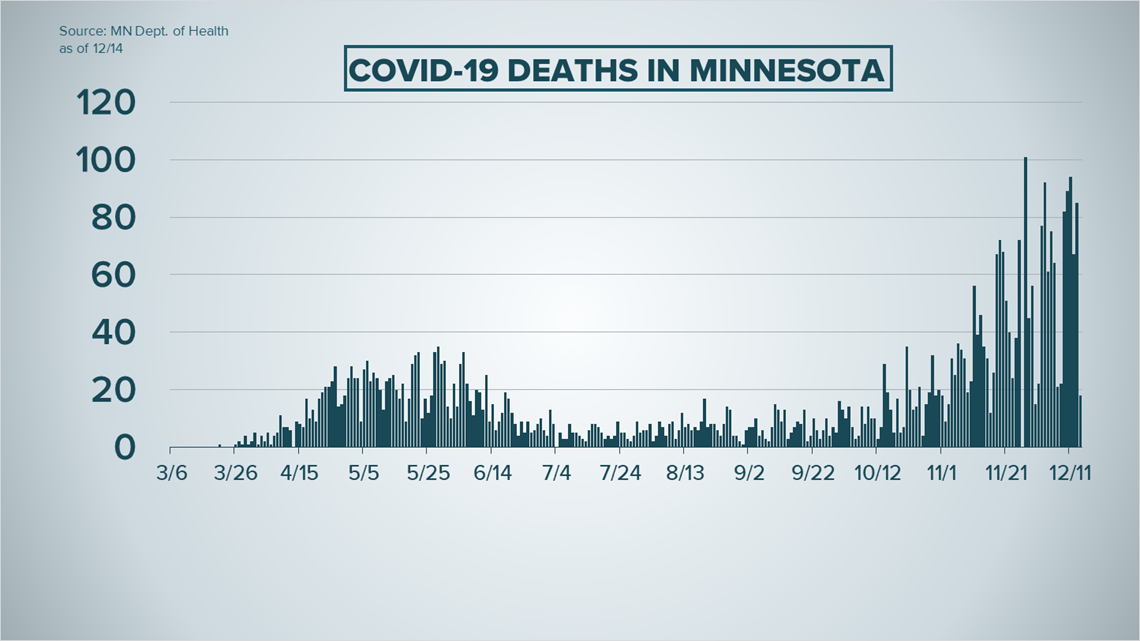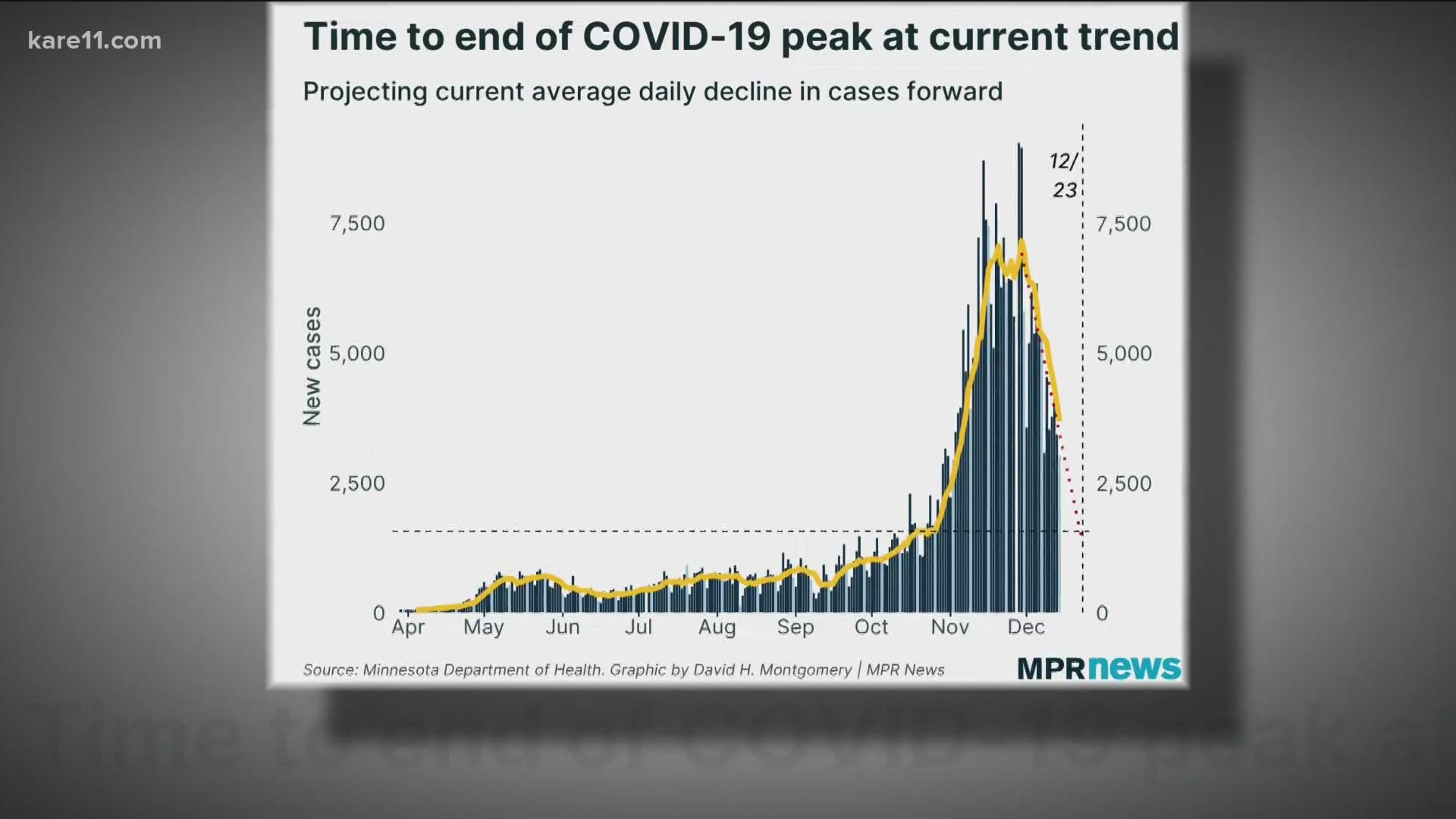ST PAUL, Minn. —
- Pfizer vaccine has begun being administered in the state
- MDH believes governor's restrictions helped prevent spread during Thanksgiving
Tuesday, Dec. 15
2 p.m.
MDH Infectious Disease Director Kris Ehresmann said that this week will be focused on educating health care providers on how to administer the COVID vaccine, which will coincide with the arrival of the next batch of vaccines for the state at the end of the week. Ehresmann noted that vaccines have already begun being administered in the state.
The current vaccine being used is the Pfizer vaccine but the Moderna vaccine is expected to get emergency approval from the FDA this week, Ehresmann said.
Providers are set to receive a higher number of Moderna vaccine doses once it is approved compared to the Pfizer vaccine.
11 a.m.
COVID-19 cases and deaths across Minnesota continued to trend downward on Tuesday, though testing numbers also dropped throughout the state.
The Minnesota Department of Health says an additional 2,340 cases of coronavirus were added to state totals over the past day, based on results from 32,117 tests (30,811 PCR, 1,306 Antigen) processed in private and state labs. Health officials consider a positive PCR test a confirmed case of COVID-19, while a positive Antigen test is labeled a probable case.
Those testing numbers are a significant decrease from the 45,341 reported tests on Monday.
The new positives bring Minnesota's total cases of the virus to 384,164 since the pandemic arrived. Of those cases, 10,672 are based on Antigen tests.
An additional 21 deaths from the virus were reported in the past 24 hours. Tuesday's reported deaths bring the total in Minnesota to 4,483 since the onset of the pandemic.


Total hospitalizations since the start of the pandemic have now reached 19,785, with 4,286 of those patients requiring ICU care.
Currently, 1,009 beds in hospitals across the state are being used to treat COVID patients, a number that is gradually decreasing. 300 people are also in the ICU, for a total of 1,309 patients being treated for the virus throughout Minnesota.
In the Twin Cities, non-ICU bed availability is improving, with 4.9% of beds open on Tuesday. However, the number of available ICU beds in the metro dropped slightly, with only 7% currently open.
Young adults make up the largest number of COVID cases in Minnesota, with 20 to 24-year-olds accounting for 39,657 cases and three deaths, followed by those 25 to 29 with 34,613 cases and five deaths. People 30 to 34 have recorded 32,002 cases with nine deaths.
The largest grouping of fatalities involves those ages 85 to 89, with 837 deaths in just 5,035 cases.
Hennepin County reports the most COVID activity in the state with 80,287 cases and 1,252 deaths, followed by Ramsey County with 34,300 cases and 593 deaths, Dakota County with 27,615 cases and 237 deaths, and Anoka County with 27,003 cases and 265 fatalities.
Cook County in northeastern Minnesota reports the least COVID activity with 97 cases and zero deaths.
Monday, Dec. 14
2 p.m.
In a press briefing on Monday afternoon, Minnesota Department of Health (MDH) Commissioner Jan Malcolm noted that it has been encouraging to see the number of hospital beds in use due to COVID trending downwards across the state. She added, however, that Minnesota is not "out of the woods," with statewide death counts from the virus still high.
Malcolm also said that there is still "a lot of virus" out there, and it is important for Minnesotans to continue, and even accelerate, the rate of improvement the state is seeing by still following guidelines such as masking and social distancing.
"We believe we can see the effects of Minnesotans taking this seriously and taking those mitigation measures to heart, and we appreciate that," she said. "We ask for people to continue to be very vigilant and help us get through this period of time in the best possible shape for our loved ones in our communities."
She said there are better days on the horizon, though, with the approval of the first COVID-19 vaccine in the United States.
According to MDH Infectious Disease Director Kris Ehresmann 46,800 units of vaccine are expected to be received across the state this week. Those will be sent to larger regional health care systems, which MDH is referring to as "hubs." From there, MDH will be using a "spoke-and-hub" model, where these larger "hub" sites will send the vaccine on to smaller hospitals and clinics, referred to as "spokes," where providers will administer the vaccine.
Long-term care residents and health care workers will be the first to be vaccinated in Minnesota, starting next week, and essential workers and older adults are anticipated to be in the second group.
The first shipment arrived this morning, and was sent to the Minneapolis Veterans Affairs Medical Center, Sanford Bemidji Medical Center, Olmsted Medical Center and Cass Lake Indian Health Services.
Ehresmann clarified that the Veterans Administration, the Indian Health Service, the Department of Defense, the Board of Prisons and the State Department are five channels who will be receiving vaccine directly from the federal government, and are therefore separate from the Minnesota allocation.
"They are on a completely different world, if you will, for vaccination," she said. "So when we talk about vaccination starting, we're talking about the providers in Minnesota that are not part of those five federal systems. So our training is for them and the plan for vaccination is for them. These other entities are separate from us, they order their vaccine separately."
Ehresmann also said it will be several months before the average Minnesotan can be vaccinated, but that these first vaccinations are a step in the right direction.
She stressed, though, that mitigation measures will still need to be practiced, even as more people get vaccinated.
"It's important to keep in mind even as we're celebrating the arrival of the vaccine, we need to continue to mask up, socially distance, and keep on with these mitigation measures," she said.
Ehresmann added that the focus in Minnesota is "safety, not speed," as the state is spending this week training workers in distribution of the vaccine. Vaccinations are expected to begin next week.
When asked to reflect on what effect the state's "pause" has had on slowing the spread of the virus, Ehresmann said that many of the spaces that have been closed since Nov. 20 are still having cases reported in connection to them due to the lag period in reporting, though those numbers have been reduced.
"What we've learned, and we continue to see, is that settings where people gather together in groups where masking is not happening or is not possible, is where we see transmission," Ehresmann said. "All of that information will continue to inform the governor's decision going forward."
11 a.m.
The number of COVID-19 deaths across the state dropped significantly Monday, according to data shared by the Minnesota Department of Health (MDH).
An additional 18 deaths from the virus were reported in the past 24 hours, down from 85 recorded Sunday. It is unclear whether the dramatic drop is due to weekend reporting. Monday's reported deaths bring the total in Minnesota to 4,462 since the onset of the pandemic.
MDH says an additional 3,026 cases of coronavirus were added to state totals over the past day, based on results from 45,341 tests (41,937 PCR, 3,404 Antigen) processed in private and state labs. Health officials consider a positive PCR test a confirmed case of COVID-19, while a positive Antigen test is labeled a probable case.
The new positives bring Minnesota's total cases of the virus to 381,841 since the pandemic arrived. Of those cases, 10,499 are based on Antigen tests.


Currently 1,283 beds in hospitals across the state are being used to treat COVID patients, a number that is dropping slowly but steadily. Of those beds 3,404 are in the ICU. Non-ICU bed availability across the Twin Cities is improving, listed at 4.7% open Monday. ICU beds are even more available, with 55 open across the Twin Cities metro (8.0 percent).
Total hospitalizations since the start of the pandemic have now reached 19,638, with 4,255 of those patients requiring ICU care.
Young adults make up the largest number of COVID cases in Minnesota, with 20 to 24-year-olds accounting for 39,478 cases and three deaths, followed by those 25 to 29 with 34,414 cases and five deaths. People 30 to 34 have recorded 31,778 cases with nine deaths.


The largest grouping of fatalities involves those ages 85 to 89, with 832 deaths in just 5,019 cases.
Hennepin County reports the most COVID activity in the state with 79,756 cases and 1,246 deaths, followed by Ramsey County with 34,016 cases and 592 deaths, Dakota County with 27,388 cases and 236 deaths, and Anoka County with 26,802 cases and 263 fatalities.
Cook County in northeastern Minnesota reports the least COVID activity with 97 cases and zero deaths.

